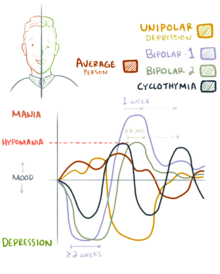This article needs to be updated. (July 2021) |

A mood swing is an extreme or sudden change of mood. Such changes can play a positive or a disruptive part in promoting problem solving and in producing flexible forward planning.[1] When mood swings are severe, they may be categorized as part of a mental illness, such as bipolar disorder, where erratic and disruptive mood swings are a defining feature.[2]
To determine mental health problems, people usually use charting with papers, interviews, or smartphone to track their mood/affect/emotion.[3][4] Furthermore, mood swings do not just fluctuate between mania and depression, but in some conditions, involve anxiety.[5][6]
- ^ Peter Salovey et al, Emotional Intelligence (2004) p. 1974
- ^ "BBC Science – When does your mental health become a problem?". BBC Science. 19 April 2013. Retrieved 8 January 2015.
- ^ Faurholt-Jepsen, Maria; Munkholm, Klaus; Frost, Mads; Bardram, Jakob E.; Kessing, Lars Vedel (15 January 2016). "Electronic self-monitoring of mood using IT platforms in adult patients with bipolar disorder: A systematic review of the validity and evidence". BMC Psychiatry. 16: 7. doi:10.1186/s12888-016-0713-0. ISSN 1471-244X. PMC 4714425. PMID 26769120.
Electronic self-monitoring of mood was considered valid compared to clinical rating scales for depression in six out of six studies, and in two out of seven studies compared to clinical rating scales for mania.
- ^ Trull, Timothy J.; Solhan, Marika B.; Tragesser, Sarah L.; Jahng, Seungmin; Wood, Phillip K.; Piasecki, Thomas M.; Watson, David (2008). "Affective instability: Measuring a core feature of borderline personality disorder with ecological momentary assessment". Journal of Abnormal Psychology. 117 (3): 647–661. doi:10.1037/a0012532. ISSN 1939-1846. PMID 18729616.
Measuring and characterizing the experience of affective instability have proved challenging, however. Traditional measures of affective instability rely on respondents' retrospective recall and subjective assess-ment of affective variability or reactivity on interview or questionnaire items.
- ^ Harvey, Philip D.; Greenberg, Barbara R.; Serper, Mark R. (1989). "The affective lability scales: Development, reliability, and validity". Journal of Clinical Psychology. 45 (5): 786–793. doi:10.1002/1097-4679(198909)45:5<786::AID-JCLP2270450515>3.0.CO;2-P. PMID 2808736.
A self-report measure of changeable affect was developed, with a goal of identification of patterns of instability in mood. Scales measuring lability in anxiety, depression, anger, and hypomania, and labile shifts between anxiety and depression and hypomania and depression were constructed. These scales were then evaluated for internal consistency, retest reliability, score stability ...
- ^ Contardi, Anna; Imperatori, Claudio; Amati, Italia; Balsamo, Michela; Innamorati, Marco (2018). "Assessment of Affect Lability: Psychometric Properties of the ALS-18". Frontiers in Psychology. 9: 427. doi:10.3389/fpsyg.2018.00427. ISSN 1664-1078. PMC 5885065. PMID 29651267.
To measure affect lability, Harvey et al. (1989) developed the Affective Lability Scales (ALS), a 58-item questionnaire measuring changeability among euthymia and four affect states (i.e., depression, elation, anger, and anxiety).